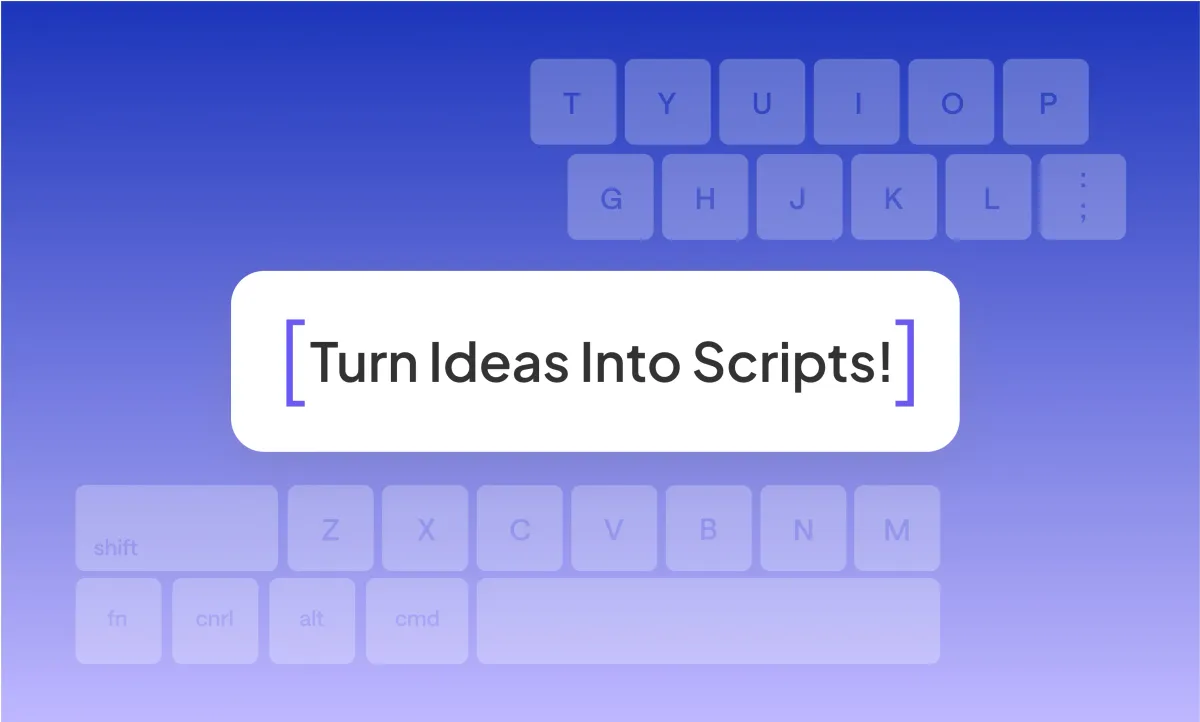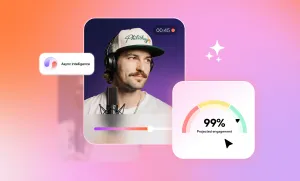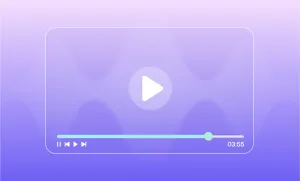If you’re taking your first steps in the vast world of video essays, then we'd better start with defining the term.
A video essay is a mix between a documentary, a commentary video, and an essay, only way more fun and engaging to watch.
It’s a type of video where the creator explores an idea, topic, or question in depth, using video clips, images, voiceover, music, and editing to make their point. Instead of just writing an argument on paper, they bring it to life using visuals and storytelling.
For example, imagine someone writing an essay about why Barbie is more than just a doll. A video essay version of that might include old commercials, scenes from the Barbie movie, news clips, and a voiceover explaining how Barbie reflects changing ideas of girlhood and feminism. Same concept, but now it’s a whole experience.
But the best video essays starts with a great script. So here’s how to write a video essay script that keeps people watching, engaged, and coming back for more.
Key Takeaways
- Video essays combine commentary, storytelling, and visuals to explore ideas, critique culture, or share personal insights in a compelling, watchable format.
- There are five main types of video essays: analytical breakdowns, cultural commentary, celebrity/character studies, investigative deep-dives, and personal reflections — each offering a unique way to engage an audience.
- Strong scripts begin with a clear thesis and structured outline, including a hook, intro, key points, and a closing reflection that ties everything together.
- Writing in a conversational tone keeps viewers engaged, especially when paired with visual and audio cues that support your message and rhythm.
- Reading your script aloud and editing for clarity, pacing, and flow is essential to ensure your final delivery feels natural, engaging, and polished.
Types of video essays
Video essays can have different purposes, such as to inform, analyze, entertain, or provoke thought, often all at once. Some break down why a movie was brilliant (or terrible), others dive into celebrity culture, internet trends, politics, or even personal life experiences. Based on their purpose, we’ve made a list of the most common types of video essays:
1. Analytical video essay
This is your classic “let’s break this down” format. Analytical video essays aim to dive deep into why something works, fails, or matters. They’re structured, thoughtful, and often feel like a mix between a lecture and a conversation with a really smart (but chill) friend. These videos often cover things like film editing, storytelling techniques, marketing strategies, or political messaging, and anything that can be picked apart and explained.
2. Cultural commentary
This format is all about examining the world around us, from celebrity drama and TikTok trends to deeper conversations about politics, feminism, cancel culture, and social media. Cultural commentary video essays feel more current and reactive. They ask: Why is everyone talking about this? What does it say about us? The tone can range from sarcastic and spicy to thoughtful and sincere. Brett Cooper’s channel, for instance, leans heavily into this format.
3. Character or celebrity study
Ever seen your favorite creator post a video on YouTube titled something like “How This Star Destroyed Their Own Career” or “The Rise and Fall of [Insert Name Here]”? That’s a character or celebrity study. This format focuses on a single public figure, it can be a movie character, a real celebrity, or even a social media personality. These essays explore their evolution, turning points, public image, controversies, and sometimes redemption arcs. The fun comes from seeing someone’s story laid out like a puzzle: what made them rise, what made them fall, and how the internet or media played a role in all of it.
4. Investigative or speculative essay
This is where things get juicy. These videos try to uncover truths, explore hidden meanings, or dive into rumors and speculation. Sometimes they’re journalistic, piecing together facts and sources. Other times, they lean into the mystery, asking big questions and inviting viewers to draw their own conclusions. This format keeps people watching because it taps into curiosity. There’s a thrill in not knowing exactly where the video is going, but trusting the creator will take you somewhere interesting.
5. Personal video essay
These are the most intimate and emotional of the bunch. A personal video essay tells a story through the creator’s own experience, whether it’s about burnout, identity, growing up on the internet, or just reflecting on life through pop culture. It’s part storytelling, part commentary, and 100% personal. These videos often don’t follow a strict structure; they feel like a letter, a confession, or a diary entry. They’re not always the loudest, but they often leave the biggest impression.
How to write a video essay script
Before you hit record, you need a solid script, which is the backbone of any great video essay. Here's how to turn your ideas into a compelling narrative:
1. Pick your topic (and target audience)
Before you write anything, choose a definite video topic, get clear on what you’re talking about, and why it matters. Ask yourself these questions: What do I want to explore or explain? What’s my main message or argument? Why is this interesting right now? Finding the answers to these questions will also help you find your target audience and know exactly what to say.
2. Research, gather sources, and take notes
Now it’s time to dig. Watch related videos, read articles, collect quotes, grab stats, pull clips. This is your “evidence”, use it to back up your ideas and theories, and add substance to your script.
3. Outline the structure
Before writing full sentences, sketch a rough outline of your YouTube video. A good video essay script usually follows this flow:
- Hook: A strong opening that grabs attention.
- Introduction: Introduce your topic and thesis.
- Body Sections: Each one focuses on a key point, backed by examples or analysis.
- Conclusion: Wrap it up, reflect, or leave viewers with a final thought.
4. Write like you speak (not like an actual essay paper)
Now that you have the structure, write the script in a natural, conversational tone. Don’t overthink it, your job isn’t to sound academic, it’s to sound human. Use pauses, sentence fragments, and side comments. It should sound like someone talking, not reading an essay off the paper.
5. Add visual and audio notes
While writing, jot down ideas for visuals or sound cues in brackets. For instance:
- [Insert clip of 2009 red carpet moment]
- [Overlay chart showing follower drop-off]
- [Use a bell sound effect here]
This helps you (or your editor) visualize how the final piece will come together and not miss any detail that could have made your video essay better.
6. Read it out loud and edit
Once you’ve written the whole thing, read it out loud, seriously, don’t skip this step. You’ll catch awkward phrases, long rambles, or moments that don’t land. Tighten it up. Cut what you don’t need. Aim for clarity, rhythm, and a tone that matches your video style.
7. Finalize and prepare for recording
After your script is polished, it’s time to record your voiceover or on-camera lines, start building the video around the script, and adjust pacing during editing if needed.
Don’t forget that even the best script might change a little in the edit, and that’s totally okay. No need to panic, just go with what feels natural!
Video essay script writing tips
- Start with a clear thesis: Don’t just describe a topic, make a point. Your central argument should shape everything else in the script.
- Write how you speak (but tighter): Keep it conversational and natural, but remove filler. It should sound like smart, thoughtful speech, not a lecture or ramble.
- Hook your audience early: Begin with a striking question, bold claim, or unexpected fact to grab attention in the first 10-15 seconds.
- Use visuals in your writing process: Think in images and clips as you write, note down where you'll insert footage, screenshots, text overlays, etc.
- Outline before drafting: Organize your script into intro, key points, and conclusion. This keeps the essay focused and prevents rambling.
- Use short sentences and strong transitions: Break up long thoughts. Use bridges like “But here’s the twist…” or “Let’s rewind a bit” to guide the viewer smoothly.
- Layer in evidence or examples: Back up your claims with clips, stats, quotes, or real-life moments. This builds credibility and interest.
- Read it out loud: This helps catch awkward phrasing, pacing issues, and tone problems before recording. If you have enough time to stall, you can let it sit for a while before coming back for a final read and edit.
- Leave space for silence or visual moments: You don’t have to talk nonstop, pause for effect, or let a scene or visual speak for itself.
- Edit ruthlessly: If a line doesn’t support your thesis or feels off-tone, cut it. Keep only what serves your message and pacing.
Create video essays with Podcastle
Now that you have your video essay script ready, it’s time to bring it to life, and Podcastle has everything you need to make that happen. From narration to visuals, you can create polished, engaging content without juggling multiple tools.
Here are 5 features that make Podcastle perfect for video essays:
- 1000+ realistic AI voices for narration, with different tones and emotions you can semantically search to match your video’s mood.
- AI-powered video and audio enhancement to clean up sound, adjust backgrounds or remove them entirely, detect filler words, and even correct eye contact.
- A built-in library of royalty-free music, transitions, and sound effects to add emotion, energy, and pacing to your essay.
- Access to high-quality stock footage and images to illustrate your points without expensive shoots or licensing headaches.
- An intuitive Video Editor to trim clips, overlay visuals, add subtitles, and assemble everything into a clean, compelling final cut.
Start creating your video essay with Podcastle today and turn your script into a powerful visual story in minutes!








